Postmodernism
¯\_(ツ)_/¯
With the exhibition Everything at Once: Postmodernity, 1967–1992 the Bundeskunsthalle, Bonn, request a more considered response.......
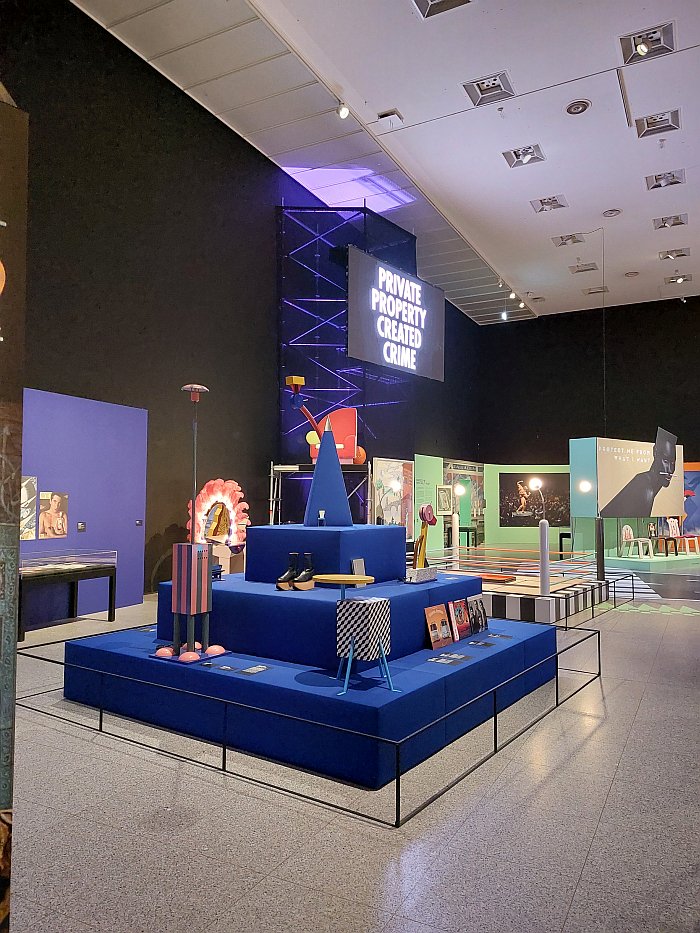
.......not that it initially appears that that is their aim: one enters Everything at Once: Postmodernity, 1967–1992 through a heavy curtain into a darkened space filled with music and videos from, amongst others, Roxy Music, The Specials or Afrika Bambaataa & Soulsonic Force, but not one notes by the all pervasive haze of patchouli the music suggests, although you can sense it in the air; a patchouli-free music box which one exits into a dark, confined corridor, passing as one does a blue and red pill from Hans Hollein's 1967 Non-physical Environmental project in which he questioned architecture, questioned what architecture is, through a collection of pills that allowed one to experience architecture non-physically. And as you listen to the music and look at Hollein's mind-altering pharmaceuticals1, you think: 1970s party. ¯\_(ツ)_/¯
And then you leave the confined corridor into a bright space, almost blindingly so after the darkness of the first rooms. Albeit an impossibly bright space to which you are initially only welcomed as a guest, separated as you are from that contained within the Bundeskunsthalle's vast exhibition space by a low plastic hedge, a low plastic hedge which, interestingly, informatively, is a lot more forceful in its defining of the limits of your movement than you would expect a low plastic hedge would be capable of, and a hedge over which you are initially obliged to look at the exhibits en mass, are obliged, if one so will, to view everything at once, and while doing so you seek to decipher that which is on display, attempt to build associations, follow lines, deconstruct relationships, spot the familiar by way of anchor points....... which, yes, is a very nice metaphor for the process of exploration in a museal exhibition. And in doing so you also notice the gap in the hedge to your left, a gap through which you sneak into the first chapter of Everything at Once.
An opening chapter which under the title Media Awakens considers developments of the late 1960s and early 1970s, a period when not only media awoke but in many regards society, or perhaps more specifically the Western European-American society that is very much the focus of Everything at Once and of which thus alone it can be a review, awoke from the enforced slumber of the War years and the subsequent rebuilding and reorganising, awoke, shook itself down began to question what it had been doing these past few decades, and sought to re-connect with where it had been decades earlier. A late 1960s in which civil rights, gay rights, workers rights, race equality, gender equality and environmental movements became ever more visible and vocal, increasingly questioning and challenging the status quos. A questioning, a challenging, a state of being awake to contemporary realities in the late 1960s/early 1970s approached in Everything at Once's opening chapter by projects such as, and amongst many others, Heinz Bienefeld's 1968 house for the Nagel family in Wesseling-Keldenich, a village half-way between Bonn and Cologne, and a house the curators describe as an "early example of postmodern architecture", where "early" can be understood as without the ostentation, debauchery, that would come, and which as such allows for a differentiated insight of the positions of the period; introduces works by writers such as, for example, Jacques Derrida, bell hook or Gilles Deleuze that provided much of the intellectual fuel for the actions of the period, and which in doing so remind that there was a theoretical basis to much of that undertaken, there were rationales, for all that many of the projects may seek to belie that basis; presents the MV1 red light-emitting diode developed by Monsanto in 1968, an object which not only allowed for analogue displays on technical devices, but in many regards started the path to the LED display technology without which our contemporary society would be unimaginable, a red LED that, literally, helped media to awaken, if a development by the same company who at the same time were producing and distributing Agent Orange and thus were deeply involved in trying to prevent human society getting this far, were trying to place human society in an eternal slumber.
And also represented by Hans Hollein's 1969 Mobile Office, another reflection by Hollein on the question as to what is architecture, and an ever joyous, ever engaging, project that, arguably, is more relevant as an actual, practicable, concept today than it was back then. And which without question is every bit as relevant as a theory and a questioning as it was when first inflated.
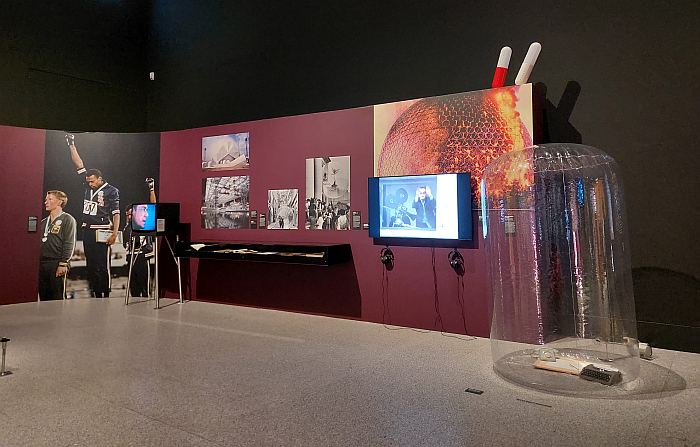
From the last years of the 1960s, that most turbulent of periods, Everything at Once's narrative unfolds in a more or less chronological journey, if one so will presents everything in sequence, that explores, discusses and contextualises Western European-American society, culture, industry, politics, economics, et al, as it hurtled increasingly radically, increasingly colourfully, increasingly ironically, sarcastically and disrespectfully, increasingly hedonistically, increasingly out of control.... until 1989. That, as noted from 1989 – Culture and Politics at The National Museum, Stockholm, most fateful of years which with its myriad implosions seemed to halt the out of control ride society was on in its tracks: everything changed, at once. Arguably much more so than had been the case after those implosions of 1968 which in many regards set society on its radical, colourful, ironic, hedonistic journey. Or perhaps better phrased, much more so than had been the case with the myriad aftershocks of those implosions of the late 1960s that set society on its radical, colourful, ironic, hedonistic journey.
A radical, colourful, ironic, hedonistic journey retraced in Everything at Once in the company of, and elucidated, explored, discussed by a broad selection of architecture, design, music, art et al projects such as, and amongst many, many others, furniture by Italian Radicals such as Archizoom, Studio 65, Alessandro Mendini or Memphis, but nothing by any Scandinavian Radicals; a Minitel terminal, an analogue predecessor of the internet that, we're all informed, was ridiculously popular in France, until the internet, that other disruptive child of 1989 caused it to become an anachronism; clothing by the likes of Issey Miyake, Vivienne Westwood, Jean Paul Gaultier, etc; or the late 1980s artwork Pasta Painting: Untitled (Mastercard) by the conceptual art collective General Idea, a work which not only takes the pasta art of childhood to extreme levels, and makes it a valuable museum piece, but also in its juxtaposition of simple macaroni with the world of high-finance poses question of the priorities of our societies, and in its reduction of a corporate identity to an anonymous abstract geometric artwork, albeit one we can all read as that corporate identity it seeks to deny, helps underscore, as discussed from Color as Program. Part One at the Bundeskunsthalle, that way we are all conditioned to read the world around us, including through colour. And a creative collective very present in Everything at Once, a (omni)presence which tends to underscore not only General Idea's importance to the period under review, but also highlights their relative anonymity today in popular discussions on the period. ¿Potentially because 'Canadian Conceptualist' is as difficult a term for contemporary society as 'Scandinavian Radical'?
And a radical, colourful, ironic, hedonistic journey that offers literary interludes, featuring as it moves numerous large format books contemporaneous of the period, including, and amongst others, Edward Said's 1978 treatise Orientalism, Thomas Pynchon's 1973 novel Gravity's Rainbow or Jean Baudrillard's 1976 position L'echange symbolique et la mort, and between whose covers one can sit and listen to selected passages and thereby expose oneself to, at least some of the, theoretical, academic, philosophical positions that informed the period. Those works, as noted above, we all to often forget exist.
And a radical, colourful, ironic, hedonistic journey that includes a stop at a nightclub space, a nightclub space that is very much an expansion and escalation of the music box via which one enters Everything at Once, a nightclub space in which to reflect on the nightclub and music scenes of the period of radicalism, colourfulness, irony, hedonism backdropped by the vulnerability, nihilism and empowerment as the Cold War raged, industrial society crumbled and the problems of human impact on the environment became ever more visible; and a nightclub space populated by photos of, and party goers at, New York's Studio 54 and Palladium and also at the Blitz club nights in London's Covent Garden, that fabled birthplace of New Romantic. And a nightclub space sound-tracked by outrageously pumping tunes.2
A pumping nightclub space we genuinely wanted to dance in. So did. Hard. Very Hard. Rarely sweated so much in an exhibition. Certainly can't remember the last time we were forced strip to the waist in an exhibition. And a pumping nightclub space we came out of to be exposed, more or less literally, to a scene from Pedro Almodóvar's 1988 film Tacones lejanos, High Heels; a scene not only most appropriate in context of late night physical exertions in close proximity to the sweaty, writhing bodies of others, but which also offers access to alternative considerations on the pumping hedonism of the period. Or does once you get over the shock.
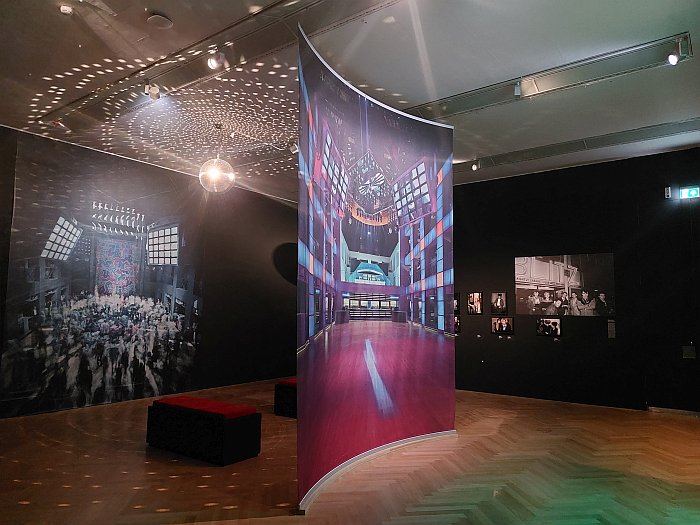
A radical, colourful, ironic, hedonistic journey that along the way introduces the political and economic realities of the period, and thereby helps elucidate the contexts in which the works on show, in which the questioning, challenging, state of being awake, of the period was undertaken, and which in doing so allows one to approach an appreciation that for all the works on show are without question works of architecture, design, music, art et al they are primarily a re-evaluation of society, represent responses to the questions what is architecture, design, music, art et al in a world that increasingly has no tangible relationship to that in which the question was once posed, but which still needs architecture, design, music, art et al.
And a radical, colourful, ironic, hedonistic journey that, as noted above, effectively ends in 1989, as, more or less, does Everything at Once with the chapter The End of History, a title taken from Francis Fukuyama's 1992 book The End of History and the Last Man, a book through which one leaves Everything at Once, and a title which is getting scarily close to being true, if not as Fukuyama imagined. Which, yes, does make passing through the book a little uncomfortable. And a final chapter whose introduction poses the question "What remains of postmodernism?" A rhetorical question, "It is established as a style" the curators continue. Has become established as something, invariably, frivolous, playful, colourful. Asymmetric. Ironic. Yet as Everything at Once helps elucidate it was a very serious period, a period of existential uncertainty, a period of fundamental questioning. If also a very hedonistic one. Or perhaps, therefore a very hedonistic one.
Yet for all Postmodernism is today a style, as Everything at Once allows one to appreciate the answer to the question "What remains of postmodernism?" is much longer and more complex than that surficial style; a complexity that the period's popular abbreviation to a ¯\_(ツ)_/¯ can all to easily blind us all to.
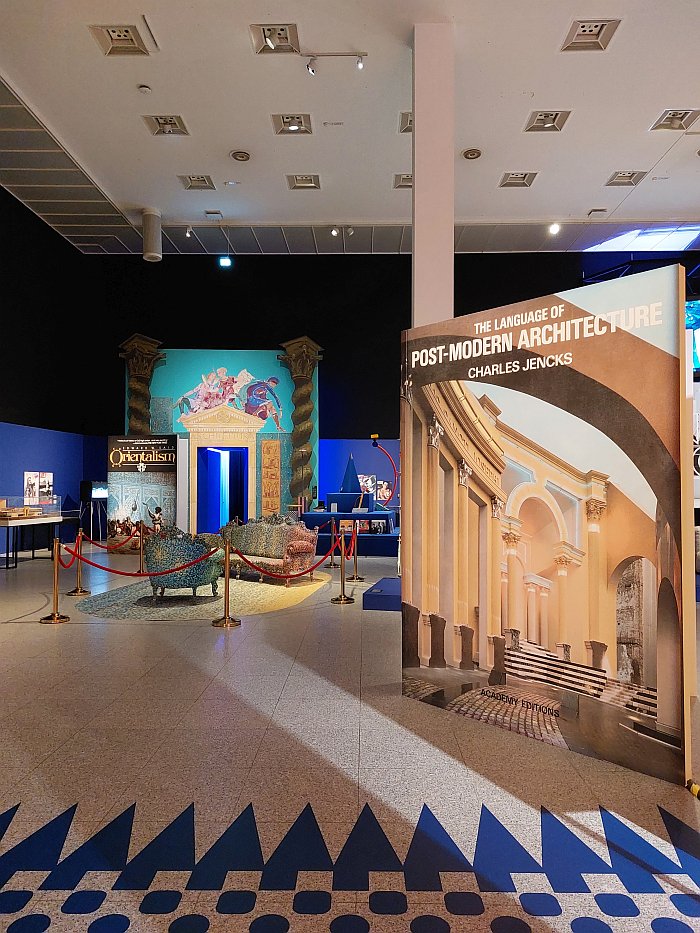
For as Everything at Once very neatly, very elegantly, allows one to appreciate, for all that the journey from 1967 to 1992 is one through an increasingly radical, colourful, ironic, sarcastic, disrespectful, hedonistic, increasingly out of control period, it was also a period in which not just 'Modern' became 'Post', but rather.......
.......whereby, if we may we'll stop here, just briefly, sorry, but it is important, because as an exhibition Everything at Once is also very much an admonishment to reflect on the term 'Postmodern', reflections that limitations of time and space prevent us from undertaking here, save to note that for all the 'modern' is popularly understood as being shorthand for 'inter-War Functionalist Modernism', not only does that definition only work for architecture and design and not for music, art, literature, philosophy, et al, but the phrase 'Postmodern' has been used since the late 19th century3, and that not least because 'modern' means 'modern', 'contemporary'. And while 'Post' can be beyond, or after, or rejection of, or development of, or replacement of, amongst other possible definitions, it always implies that something was there which is now not, or not as it was or at least is in the process of becoming something different, and that that which was there, but which is no longer there, was 'modern'. 'Contemporary'. Which of course is what that which is now there is.4 Or put another way, if Postmodern ended in 1992, what came after it? Postpostmodern makes no sense, don't even think about going down that path, its a dead-end. If that produced in the late 1980s was 'modern', was 'contemporary', which it was, then that which came after it was 'Postmodern'. Although that had ended. Although that being produced today is 'Postmodern'. And is also 'modern', 'contemporary'. Or put another way, do we not experience past, preset and future simultaneously, everything at once?
In many regards the one song missing from Everything at Once is The Smiths How soon is now?, a song from, and very much in, of and in context of the period under discussion, that in many regards encapsulates much of the spirit and mood of the early 1980s, that sense of everything at once the curators seek to highlight; and a song whose central refrain is inspired by a passage from George Eliot's 1871 novel Middlemarch, and is Eliot not a representative of a 'Postmodern' period in English literature, a 'New Romantic' period, before it became the 'Modern' and 'Romantic' of a 'Postmodern' and 'New Romantic' period, thus doubling down on How soon is now? as a 'Postmodern' work.
And while, yes, one can limit 'Postmodern' to the 1970s and 1980s by defining 'Modern' in such a way that it only covers the first decades of the 20th century, not only does that involve an awful lot of theoretical gymnastics, tying yourself in knots to avoid the pitfall of contradiction, and a little bit of disingenuous subterfuge, and a lot of ignoring that which doesn't fit your theory, but also in its working backwards to a definition of phrase that starts with 'Post' admits that the phrase 'Postmodern' is faulty. Doesn't work. But does satisfyingly help highlight all the problems and faults in the term 'Modernism'. A subject in itself. And don't get us started on 'Prehistoric'.
Thus the more one considers 'Postmodern', the more one reflects on 'Postmodern' in its various and varied and unrelated contexts and expressions, the more one views Everything at Once and its myriad projects and positions, the better one appreciates that 'Postmodern' is a phrase which can be taken as meaning everything at once, and which through describing everything at once also describes nothing; and appreciating the impreciseness of the phrase, allows one to step away from it. And more observant readers will have noted how studiously we've avoided using it until this section, because having viewed Everything at Once, we can't use it. And can't imagine we will ever actively use it again; Everything at Once very much demanding more precession in discussions on architecture, design, music, art et al in the 1970s and 1980s, very much demanding a move away from attempts to use a single phrase to define the complexity of the relationships and differences of the creative expression and philosophical basis, and pumping tunes, of the period through simplifying the discussion down to a catch-all, everything at once, term, a term, a ¯\_(ツ)_/¯, which as Everything at Once tends to underscore, can stop one learning from the period.......
.......but as we said reflection on 'Postmodern' demand more space than is available here, a lot more reflection on 'Modern', and a lot more reflection on if what is actually meant isn't in fact 'Postenlightenment' with all the problems that then brings for the established timescales via which we view human society, its progress and movement, and so we'll leave those reflections here and return to Bonn.......
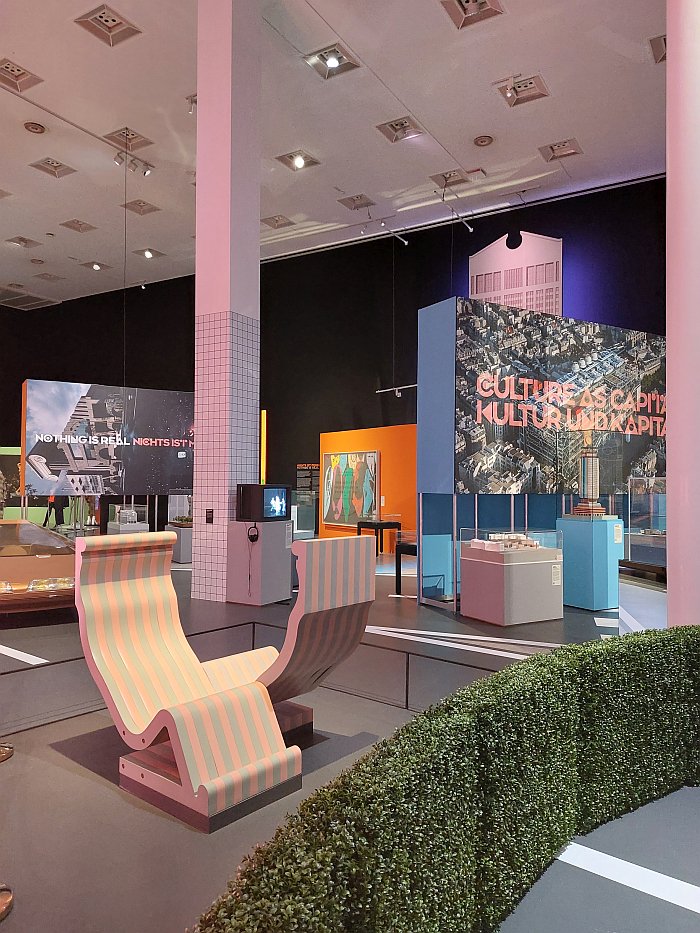
For as Everything at Once very neatly, very elegantly, allows one to appreciate, for all that the journey from 1967 to 1992 is one through an increasingly radical, colourful, ironic, sarcastic, disrespectful, hedonistic, increasingly out of control period, it was also a period in which not just 'Modern' became 'Post', (as it always does), but more specifically architecture, design, music, art et al became 'Post', that is remained architecture, design, music, art et al but not as they had been, one could argue that cultural became 'Post', and that not just because cultural forms of expression became increasingly accessible to all, and that not least through the awakening media of the first chapter, but for all cultural forms of expression started to be reflective of and responsive to all and not just the upper echelons of society who previously had been the consumers of culture. Yes, we're generalising more than is prudent, popular culture goes back centuries, we're not denying that, but we would argue that a definite movement towards culture as a common good of all and not a preserve of the wealthy can be followed throughout the period, of culture, cultural expression, becoming an identifying factor accessible to all and not a preserve of the wealthy, and the thereby associated increasing insistence by all for the right to their own forms of cultural expression, their own definitions of culture, their own identity through culture rather than through class or clan or profession or nationality, and also the right to switch ones culural identity; and something witnessed not least through the novel forms of cultural expression that arose and challenged the established formats.
Similarly Everything at Once also allows an argument to be constructed that in the 1970s and 1980 'function' became 'Post', that it was a period when definitions of function were greatly expanded, when 'function' ceased to be a purely physical characteristic and increasingly became metaphysical; similarly the 'need' question in context of objects of daily use became a much wider formulated question, 'need' no longer being something practical but also an intangible entity; changes that not only altered relationships with our objects of daily use but also challenged the legitimacy and validity of the established relationships, and thereby challenged the legitimacy and validity of the society, of the 'function' of the society, the 'need' for the society, that had established those relationships.
A challenging of the established that Everything at Once particularly highlights in context of gender and sexuality, exhibits such as the aforementioned scene from Tacones lejanos, a film inspired by queer culture in 1980s Barcelona, or through the presented images of androgynous youth on the streets of central London, and bondage gear as clothing appropriate for social occasions, not only being the sort of images that would cause the Hungarian authorities to slap a 18 certificate on Everything at Once, but helping elucidate that the 1970s and 1980s was a period when gender and sexuality also became 'Post', and also a little 'Pre': in previous centuries questions of gender and sexual orientation weren't regularly posed, weren't an issue, until the Victorians got all upset about everything (at once). An elucidation of the increasing 'Postness' of gender and sexuality deliciously underscored, celebrated one could argue, by one of the final exhibits in Everything at Once, a brief out-take from Sally Potter's 1992 film based on Virginia Woolf's 1928 novel Orlando, a novel whose eponymous lead character is physically, as in actually, gender fluid, very much 'Post', and very much emotionally and sexually active as both gender expressions of Orlando, with all the questions and challenges that contained for a 1920s society struggling with its Victorian upbringing; and an out-take from Potter's adaptation that focusses on Jimmy Somerville's rendition of the song Coming with its repetitions of "I am coming! I am coming! Here I am! Neither a woman, nor a man ... At last I am free!"
Thoughts on the 1970s and 1980s as a period of "neither a woman, nor a man" nor of a hetero or a homo sexuality, which alongside the reflections and discussion on the myriad 'Posts' of the period, including one must add Hollein's Mobile Office as 'Post' office work, as a very contemporary refusal to go to the office, that allow one to better appreciate that "What remains of postmodernism" is the society that we have today; or more accurately, the Western European-American society that is the only society one can reflect upon in Everything at Once, is a consequence of the questioning, challenging, being awake to contemporary realities of the 1970s and 1980s, is a consequence of the responses to the questions what is architecture, design, music, art et al of the period, the re-evaluations of culture at that period, and the associated re-evaluations of society. And also a consequence of the responses to those responses and re-evaluations, both those that accepted and embraced them and those that rejected them, there having always been those dismissive of the those seeking a 'Post', of those awake to contemporary realities. And potentially always will be, the key question being how the thus arising debate is undertaken, by both sides.
Thus Everything at Once is an apposite and timeous reminder that we today are laying the foundations for coming society, and thus a reminder that our responsibilities go beyond those to ourselves; that it may be time to leave our hedonistic youth behind us and to think more collectively.
A shift that requires to first of all relive that hedonistic youth and to objectively, soberly assess a period that at the time passed us by in a blur, but which informs and defines our contemporary society.
Everything at Once is an excellent space to begin that assessment. But can be but a beginning.
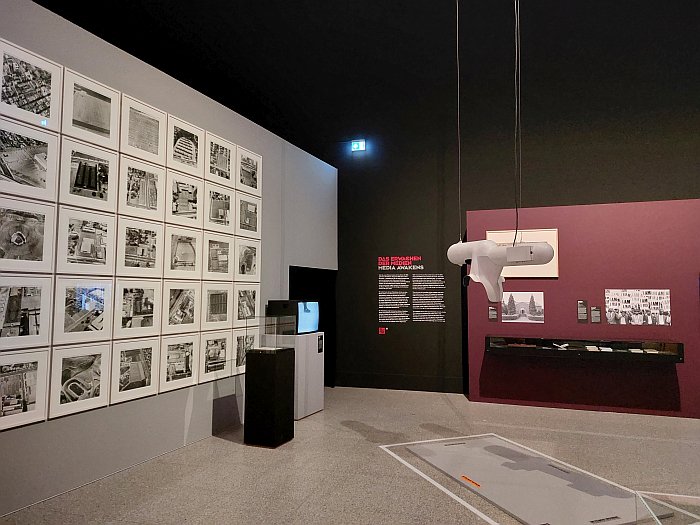
A pleasingly wide ranging and varied exhibition which gives you the time and space to view it at your own pace, doesn't demand as you initially fear that you consider everything at once, and that, not inappropriately, in an early 1990s building by Gustav Peichl that is as much a product of the age as is that on display, Everything at Once presents alongside many familiar objects, yes, at times a little obviously so, and, yes, a presentation in which, as you my have noticed, we did miss works from outwith the Western European-American perspective, also includes numerous surprises, numerous moments that one wouldn't necessarily expect, including, for example, a blue light-emitting diode, one of the last exhibits on show, and a development from 1992 which through linking back to the red LED met in the opening chapter, and the green LED from 1972 which we didn't see and so either we missed it or it not there, helps frame the period in context of not just the radical, colourful, ironic, hedonistic, et al, but also in context of developments in rational, sober science and technology, rational, sober science and technology that 'Postmodern' is often set as antithesis of, a rejection of, but which exist, and always will exist side by side. And thus reminds us all that developments in any society are a complex mix of differing influences, and also tends to imply that our contemporary mobile digital technology is something else that remains from 'Postmodernism'. Or a least from the 1970s and 1980s.
Similarly Trever Fiore's 1980 Karin concept for Citroën, the first car with a computer, and with controls for telephone, yes, telephone in 1980, and radio on the steering wheel; and a work which formally finds an echo today in the Tesla Cybertruck, albeit without the arrogance and violence of the Cybertuck, without that embodiment in the Cybertruck of the debate culture on X and, one fears, the world an Elon Musk is driving us towards; Fiore's Karin is a much more inviting, open, if very hedonistic, personality. Somewhere you actually want to be rather than something you fear becoming.
Then there is a photo by Elliot Erwitt of Arnold Schwarzenegger throwing a pose in front of an admiring crowd, an image that resembles the work of some Flemish Master depicting a scene from Antiquity, not least in the way the light catches, and further illuminates the already radiant faces of those staring with heightened religious fervour at Arnie's improbable plasticity. And an admiration of the muscular, a replacing of character with muscles, that we are reliving today, and which poses questions about the border between egoism and self-expression in the 1970s and in the 2020s. As does Arnie's very obvious lack of tattoos. Unimaginable today. With all the thoughts that allows on an Adolf Loos' position of a passion for ornamentation as a reliable indicator of a retrograde culture.
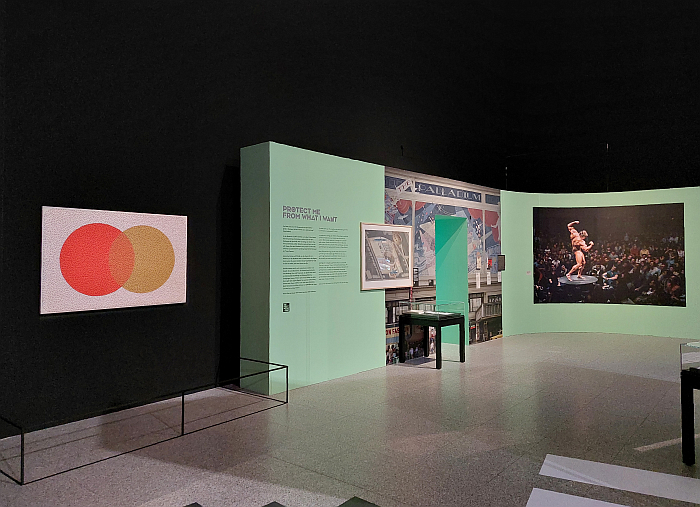
Or, the discussion surrounding the construction of the new Schirn Kunsthalle in Frankfurt in context of its relationship to the neighbouring Middle Age's Römerberg, a controversy, and a solution, we were thoroughly unaware of, but which will chase and return to; as we will also return at a later date to the plans for the DDR Pavilion at Expo '92 in Sevilla..... you do the math. How did the DDR government envisage the world after 1992? Did they imagine themselves in it? And what do the DDR's plans for 1992 tell us about living in the future rather than the now of the youth at Studio 54 and Blitz? And, yes, the DDR was outwith Western Europe, but in a very unique context that makes it more visible today than its eastern neighbours. If still less visible than the BRD. Obviously.
While the aforementioned regularity with which General Idea are present is, as already noted, a nice reminder of their importance and relevance, as is one must add the regularity with which one meets projects by Hans Hollein, an other all to often overlooked protagonist of the period; and an importance and relevance of General Idea tending to be underscored by their domination of the final chapter with their AIDS wallpaper that borrows so openly from Robert Indiana's LOVE, a work by Indiana from 1964 and so not 'Postmodern' but Pop Art, which was obviously 'Postmodern', and also the abundance of pills of various sizes by General Idea whose connections with AIDS allow them to stand in conversation with Hans Hollein's pill met at the beginning of the journey, and which allow for reflections on the similarities and differences of pharmaceutics as alterers of physical and mental realities. And also allowing for reflections on AIDS as that other unignorable institution of the period. And a reminder that alongside culture, science and technology disease also defines the path any society takes. And the urgent need in context of our climate emergency to consider our definitions of 'disease'.
Much as Everything at Once is a reminder of the urgent need to consider in more detail 'Postmodernism', to consider with more precision and objectivity the period 1967-1992 of Everything at Once's subtitle. A process that has of late been undertaken with more intensity and regularity than was the case; as previously opined the increasing distance to the period allowing us all to focus better on it. And whereas a show like Années 80. Mode, design et graphisme en France at the Musée des Arts décoratifs, Paris, took a very national, and temporally limited, view of the period, or Schrill Bizarr Brachial. Das Neue Deutsche Design der 80er Jahre at the Bröhan Museum, Berlin which focussed on but one moment , or Anything Goes? Berlin Architecture in the 1980s at the Berlinische Galerie, Berlin, with its focus on just architecture and urban planning, in a very regional focus, and limited temporal space, in taking a much wider view, considering everything at once rater than in isolation, if, yes, in the geographic isolation of its Western European-American context, Everything at Once offers an easily accessible, stimulating and highly entertaining introduction to the complexities, depths, and ongoing relevance of the period.
And in doing such encourages us all to move on from the easy objectification of the few objects we all know from that period, to move away from the style we all too easily consume, reduce the period down to, and to move towards more probable understandings of the period; admonishes us all to focus less on the works as on the whats, whys and wherefores of the works, admonishes a move towards discussions based on that inherent in the works, rather the works as examples of a popular pigeon holing by way of simplifying discussions, a move, a repositioning, Everything at Once undertakes and thereby helps elucidate the urgent need for us all to move beyond ¯\_(ツ)_/¯
Everything at Once is scheduled to run at the Bundeskunsthalle, Helmut-Kohl-Allee 4, 53113 Bonn until Sunday January 28th.
Full details, including information on the accompanying fringe programme, can be found at www.bundeskunsthalle.de
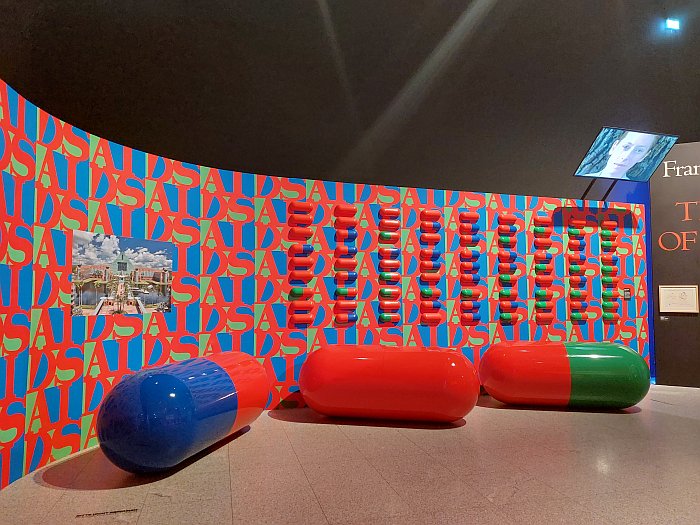
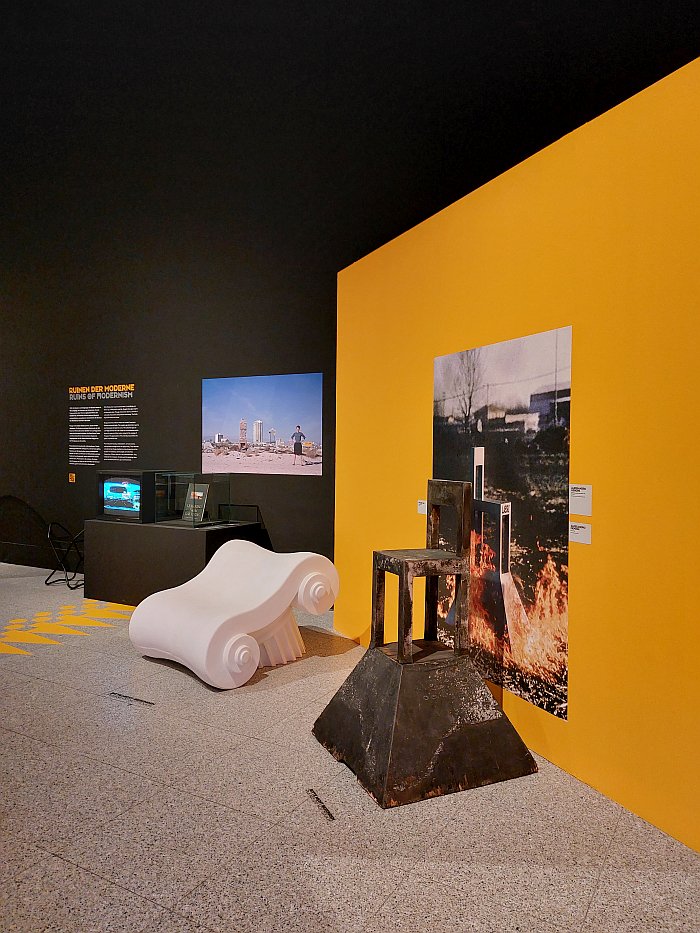
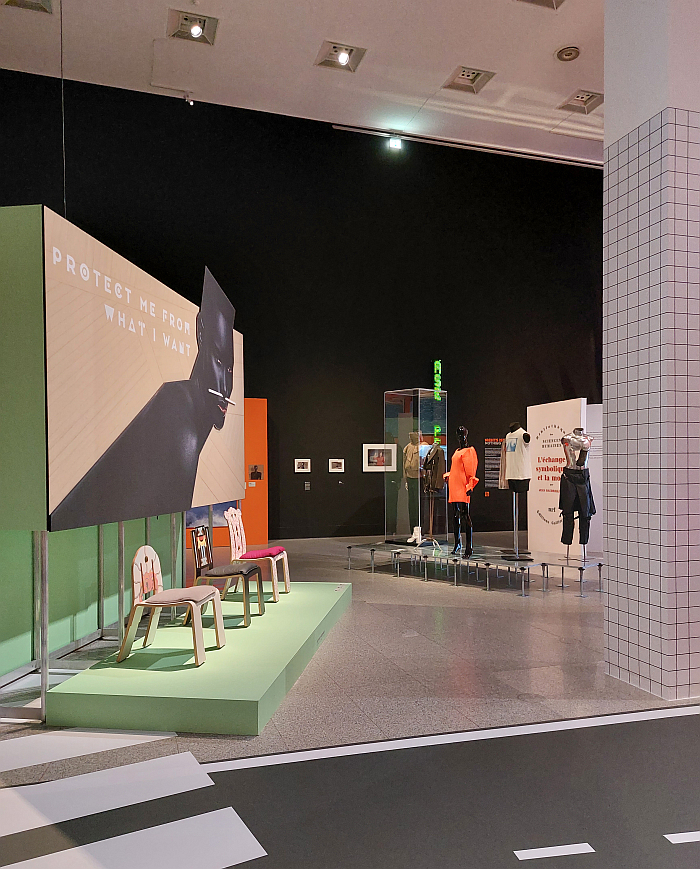
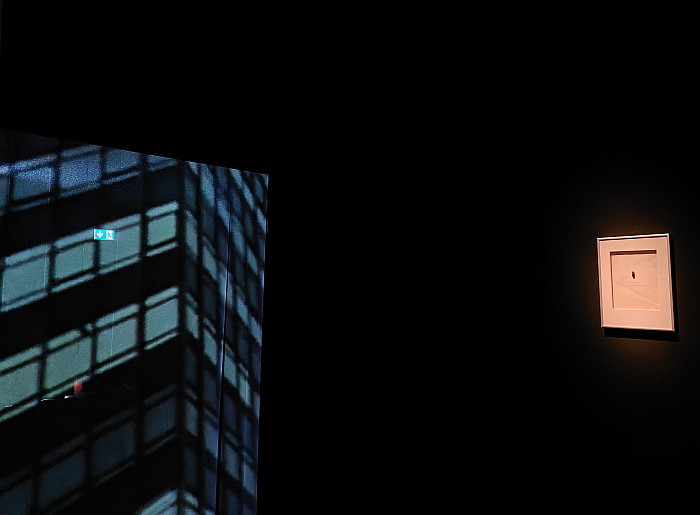
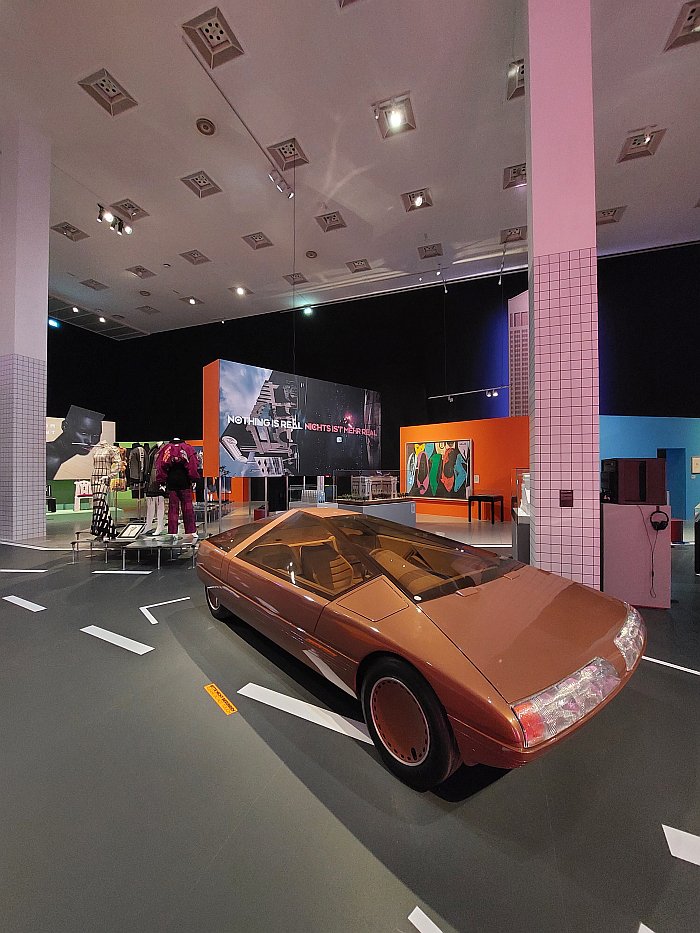
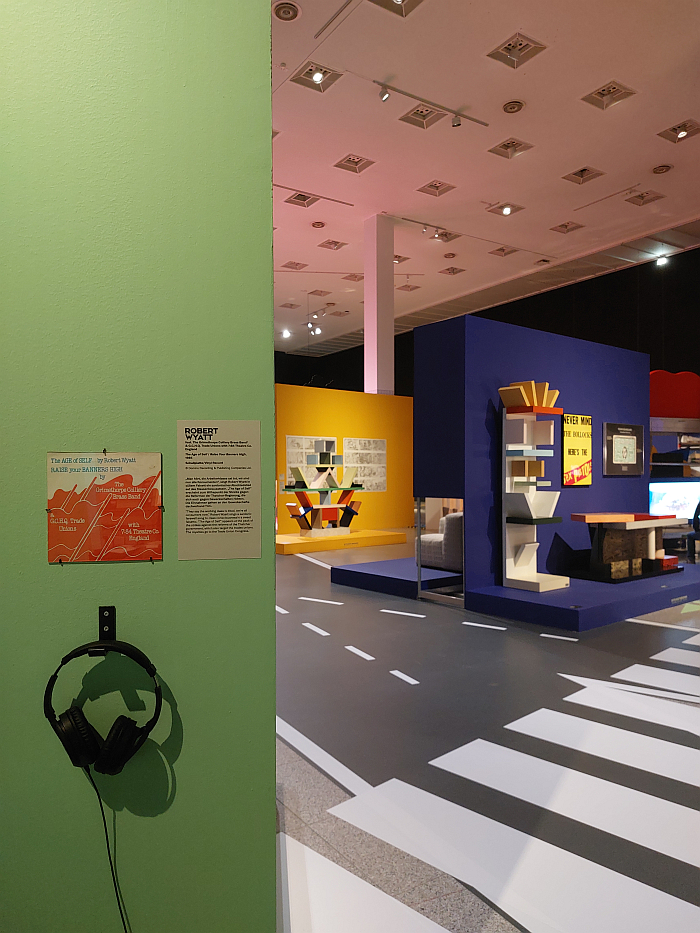
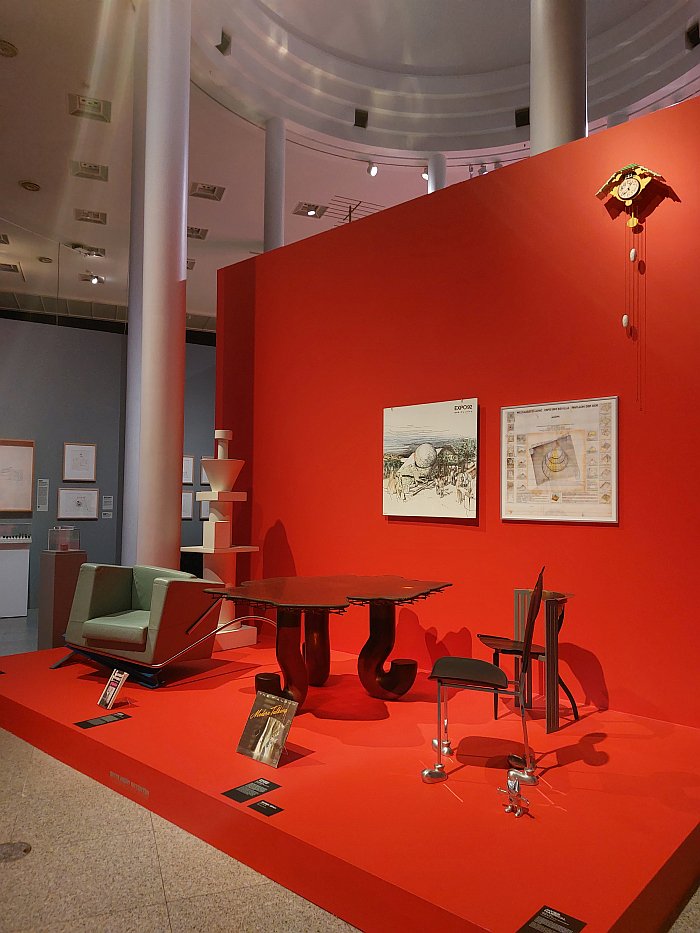
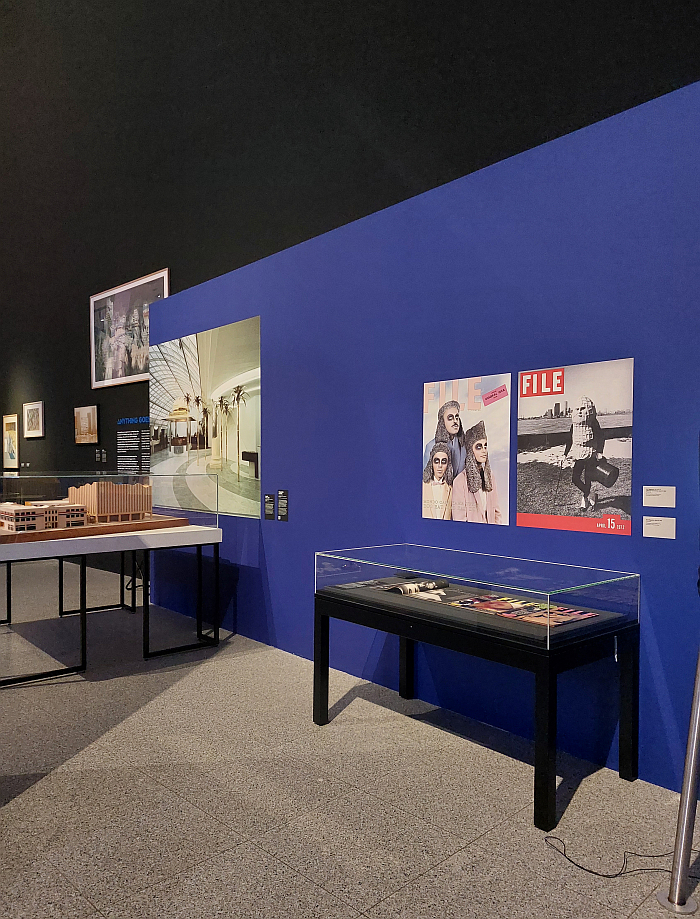
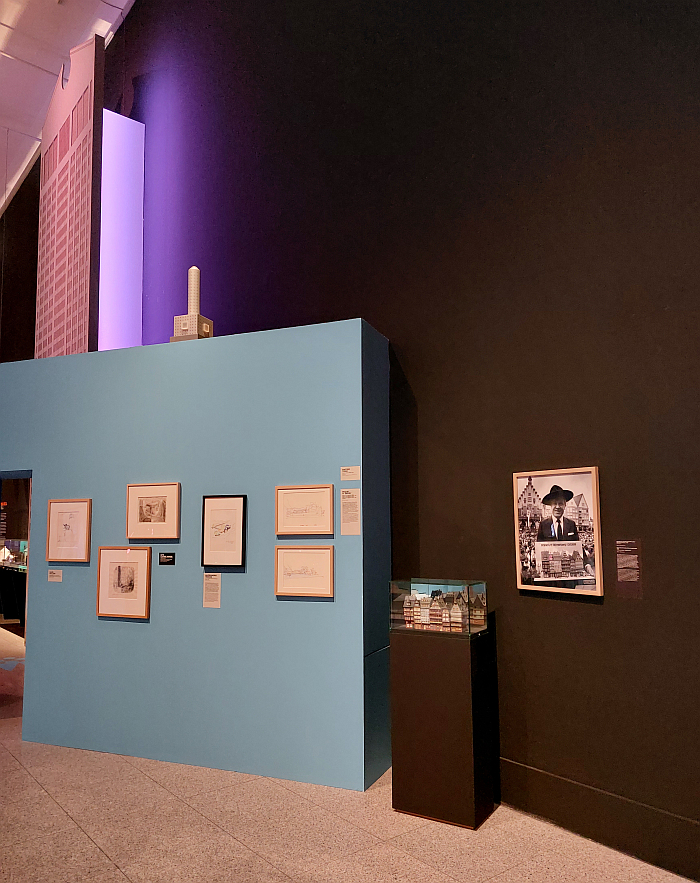
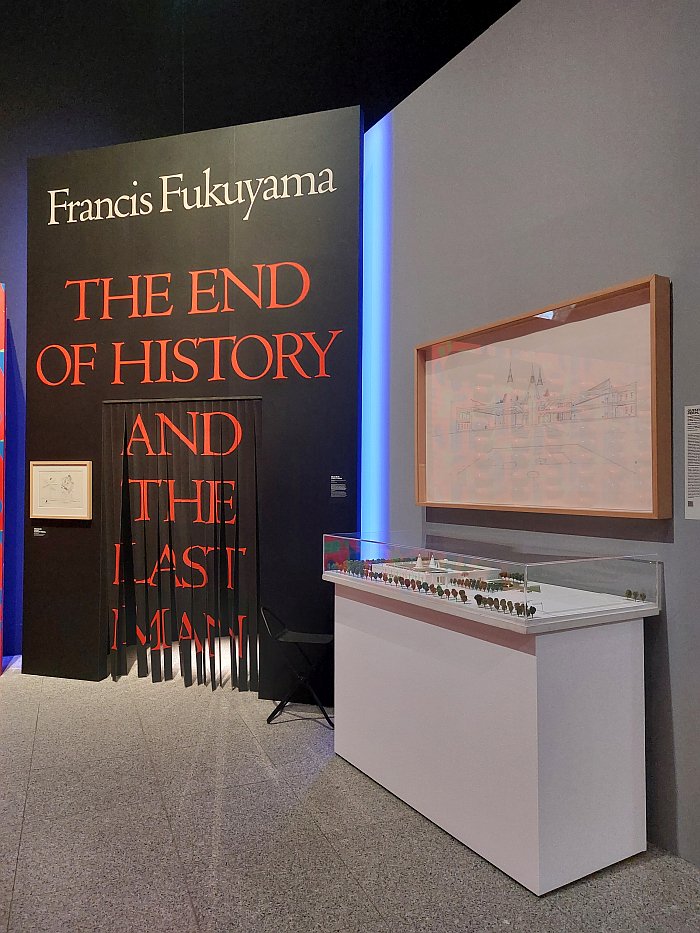
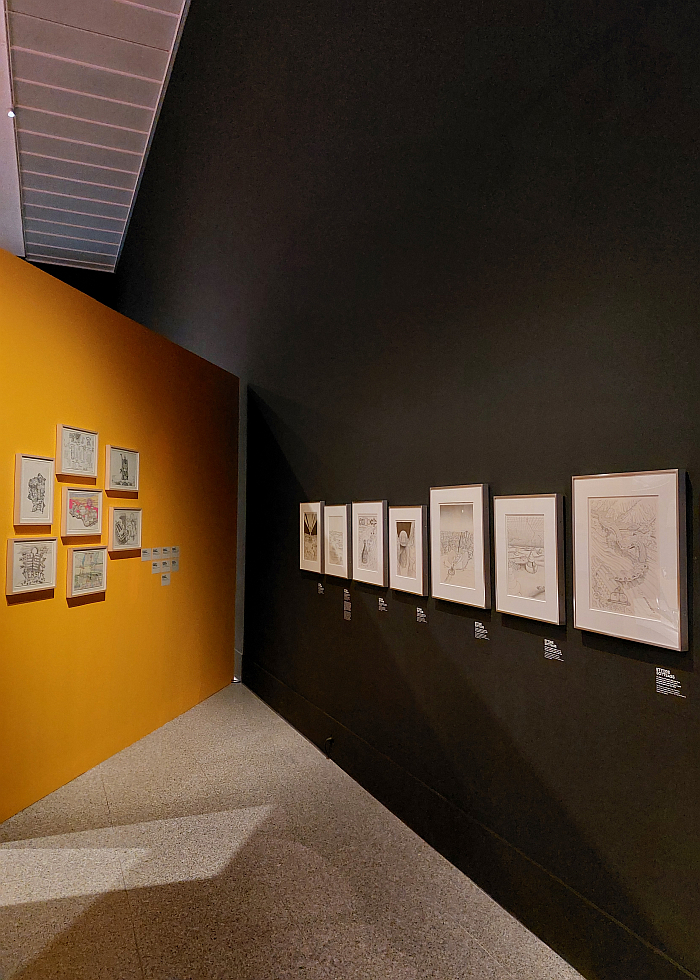
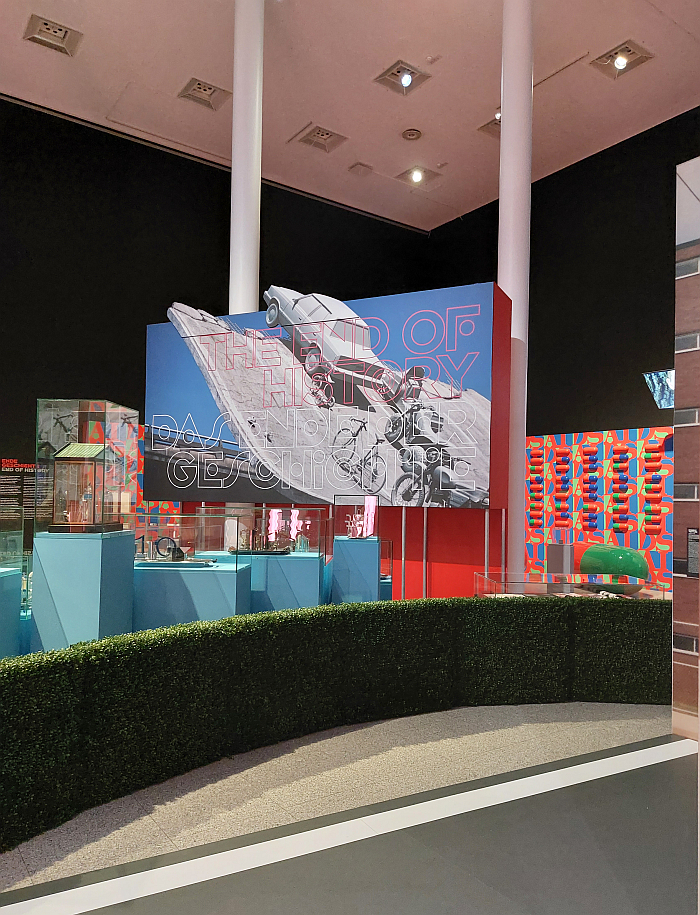
1Important to point out they weren't actually mind-altering pharmaceuticals, weren't even pharmaceuticals, but props by way initiating a "what if?" debate.......
2We are very carefully using the term 'nightclub' here because amongst all the music that is present in Everything at Once there's no disco, yet disco arose and achieved its zenith in the period under review, in context of many of the themes discussed, as a consequence of a questioning of the established, is therefore disco not 'Postmodern'? Or is it like Scandinavian Radical to difficult to fit under that umbrella. (We may of course have missed the disco, but the argument is still valid). Punk as such also seems to be missing, although there is a lot of 'Postpunk', but surely Punk was 'Postmodern'?
3There is a widely quoted reference to the use of the term by the English painter John Watkins Chapman sometime around 1880 in which he employs the term by way of differentiating the work of him and his colleagues from that of the French Impressionists without being disparaging about the French. We've been unable to track down the original text, but it is widely referred to thus we tend to accept it, but haven't actually seen it. We are still searching.
4Clearly not everything produced today is seeking move forward a lot is treading familiar water in the hope of commercial gain.... but is that not also modern? Contemporary?, And what are 'revivals'?... thoughts which highlight that the basic problem is the poor, faulty definition of 'Modern' and thus the impossibility of using a phrase such as 'Postmodern' if 'Modern' isn't a tangible thing. And thereby of the need for more precise language.